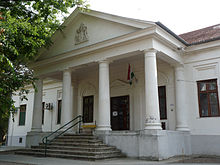This article needs additional citations for verification .(September 2009) |
Abony | |
|---|---|
 Aerial view | |
| Coordinates: 47°11′22″N20°00′35″E / 47.18944°N 20.00969°E | |
| Country | Hungary |
| Region | Central Hungary |
| County | Pest |
| Subregion | Cegléd |
| Area | |
• Total | 127.97 km2 (49.41 sq mi) |
| Highest elevation | 100 m (300 ft) |
| Lowest elevation | 90 m (300 ft) |
| Population (2008) [2] | |
• Total | 15,681 |
| • Density | 120/km2 (320/sq mi) |
| Time zone | UTC+1 (CET) |
| • Summer (DST) | UTC+2 (CEST) |
| Postal code | 2740 |
| Area code | +36 53 |
| KSH code | 27872 [1] |
| Website | www.abony.hu |
Abony (German : Wabing) is a town in Pest County, Hungary.





